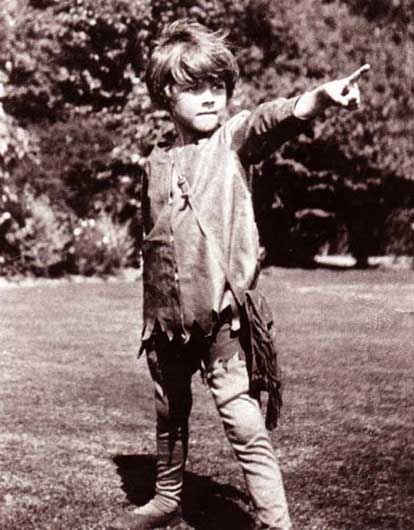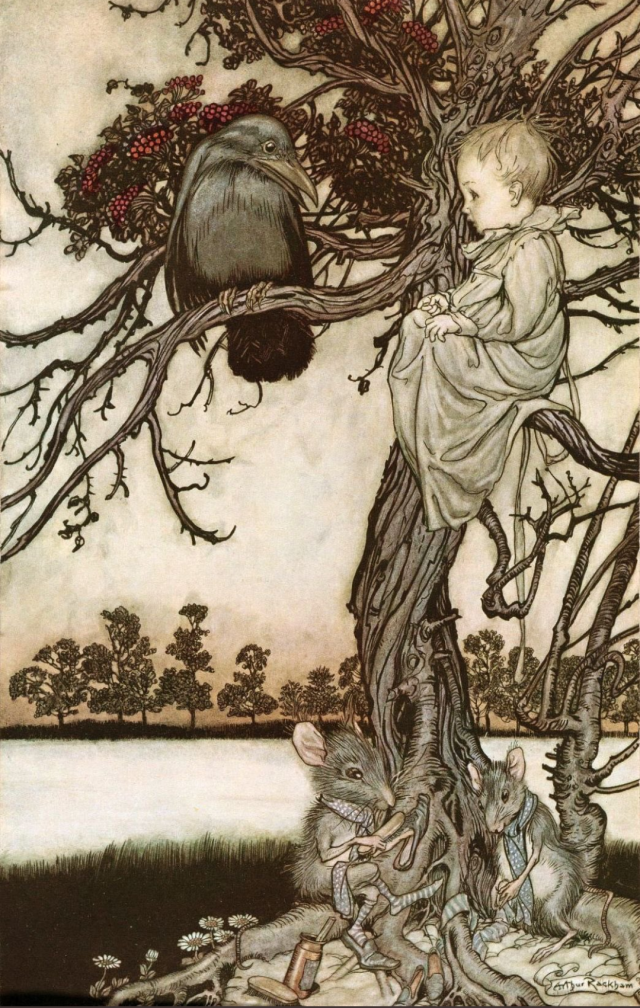
‘Peter Pan in Kensington Gardens’
by J M Barrie, in Peter Pan etc,
illustrated by Arthur Rackham.
Wordsworth Classics 2007 (1906/1902)
Before Peter and Wendy (1911) there was this, Peter Pan in Kensington Gardens (1906), published with illustrations by Arthur Rackham; and before that there was the stage play Peter Pan; or, the Boy Who Wouldn’t Grow Up (1904) following on from The Little White Bird (1902), from which Peter Pan in Kensington Gardens was later extracted.
Amongst all this convoluted literary history are mingled clues to Barrie’s own psychology, hints about his relationship with his mother and his deceased brother David, and his relationship with the five Llewelyn Davies boys and their mother, Sylvia. Fascinating though these aspects may well be to many readers I’m more interested in the story which unfolds in the six chapters and the impact it may have on the innocent reader.
I say “innocent” reader, but it’s hardly easy to banish from one’s mind the boy who wouldn’t grow up in Peter and Wendy and in the many versions and retellings that have sprung up in the century or so since the play first saw the light. Here, instead of a boy “clad in skeleton leaves and the juices that ooze out of trees” we find a week-old baby who matures without getting older, and instead of the varied geography of Neverland the action takes place almost exclusively in one of London’s Royal Parks.

The first chapter is, I think, the most disconcerting. The narrator takes a little boy, David, on a grand tour around Kensington Gardens bounded, then as now, on the east by the lake called The Serpentine and, beyond, Hyde Park and on the west by Kensington Palace. An attached map helpfully gives David (and us) the layout of the grounds, with features given alternative names in keeping with the story which the narrator and his charge develop together. We, the readers, are addressed as though we were David’s age, on an anecdote-filled transit of the gardens.
Then we are introduced to Peter Pan as though he is a figure from folklore known to generations before David, perhaps going back to Regency times or earlier. Is he a baby? Undoubtedly, for Peter has floated out of his nursery window and into the public gardens. Is he a personage known from pagan beliefs? Indubitably, for he plays panpipes and is known to ride a goat. Is he both at the same time? So it seems.

Through this chapter and the next we learn how he discovers his nature and talks to birds, is advised by a wise crow and is granted wishes by the fairies, has a boat made by thrushes and returns home to see his mother. This last excursion is fraught with peril: will he prefer his new outdoor life or take pity on his distraught mother, will the window remain open or will it be barred, with glimpses of another baby in his mother’s arms?
Kensington Gardens has a further peril: every evening sees lock-out time when visitors must leave and the gates are clanged shut. Woe betide any children who are left inside for the fairies may mischief them! What will happen to four-year-old Maimie who deliberately hides in the snowbound park? Will she survive, and how so, will she follow Peter’s example and will the fairies take pity on her? And how does Peter acquire the goat with which he is later associated?

In many ways Peter Pan in Kensington Gardens is a very different beast from its more famous incarnation. Though sharing some features it is altogether more parochial and its fairy court more bourgeois than Neverland’s denizens, and there is less of a sense of continuous or immanent danger. However, despite its odd beginning I was surprised to find myself frequently charmed (when I wasn’t over-analysing), in the same way I was by the opening chapters of Charles Kingsley’s The Water-Babies. That charm came through in little misunderstandings, for example when Peter and Maimie are at cross-purposes when they swap a thimble for a kiss, and in the narrator’s observation of the kinds of logic that arises from a child’s viewpoint.
It is sentiment that, for me, characterises this novella, much as it does with Peter and Wendy: the yearnings for maternal contact and friendships and the musings on birds as the souls of babies. Also colouring it all is an impulse for exploring unknown regions: there is a premonition of Peter’s famous cry — “To die would be an awfully big adventure” — in this final chapter when parish boundary stones are interpreted as gravestones for babies. Barrie’s own acquaintance with loss inspires the ground bass underlying this strange fantasy.
A final word on the illustrations by Arthur Rackham is now due. Though this edition only reproduces some of the original plates and line drawings in black and white, Rackham’s bravura colour paintings are what make Peter Pan in Kensington Gardens something special. While F D Bedford’s engravings are perfectly adequate for the 1911 novel, Rackham’s embellishments are simply magical.
3/21 TBR Books in 2021

A great post (and /another/ map!). I find this version of the Peter Pan myth very difficult, confused and confusing, but I only came to it after reading Jaqueline Rose on Peter Pan, and her emphasis on the macabre side(s) of the Peter Pan corpus colour my thinking. I hadn’t seen that “bourgeois court” aspect, and now I wonder “how could I have missed it?”
LikeLiked by 2 people
The cartographic novel is queen! I shall be commenting on your stimulating post when I’ve got my thoughts together—I’m currently fleshing out my map of UKLG’s Orsinia during my read of her Malafrena, a very engaging homage to the 19th-century novel and way, way more satisfying than I expected, even for Le Guin!
PP/KG is indeed a weird mishmash, partly due I’m sure to being extracted from a longer novel (and now I wonder how confused and confusing that must have been). The Gardens’ Seelie Court I just saw as a reflection in miniature of the more ridiculous aspects of late Victorian / Edwardian society in London, exaggerated for effect. Must look out out for the Rose study, looks appetising!
LikeLike
I don’t remember much of the more popular version of the story other than Nana and that it was a lot darker than I had expected. But this sounds really intriguing although also a touch weird, too perhaps. But all of most of Pan’s avatars seem to have a touch of the unsettling in them I think, except may be Dickon in the Secret Garden
LikeLiked by 1 person
I think Pan, being the personification of all that is wild in nature, is always going to be unsettling, however civilised a gloss is placed on him.
To Dickon’s more gentle nature I’d add the goose boy Simon in Joan Aiken’s The Wolves of Willoughby Chase, but other literary manifestations — and there are many, aren’t there! — have a more dangerous or awesome aspect. Here I’m thinking of Pan in The Wind in the Willows and Nesbit’s spirit in The Enchanted Castle, graduating via Peter Pan to Arthur Machen’s wild man-beast in The Great God Pan.
It’d be an interesting exercise I think, Mallika, to compare the demigod with goat features to the stag-antlered Cernunnos figure in souch other traditions and fantasies — I may even try it some day!
LikeLiked by 1 person
I agree.
Yes, Simon was a gentler version as well. I remember shades of Pan in Robin in the Little White Horse–also on the same lines.
The one in The Wind in the Willows I loved–unsettling yes, but the image of the baby otter (Portly?) in his lap is such a sweet one, I always associate more pleasant thoughts with it.
Do write a comparative post, I think it will be fun. In fact even these various incarnations that Pan has in these would make for a great comparison.
LikeLiked by 1 person
I’m inspired and encouraged to do just that, thanks! And yes, the baby otter image is perfect and comforting.
LikeLiked by 1 person
Well I haven’t even read Peter and Wendy and certainly after reading this must put that right – I’ve learnt that I have a lot of catching up to do with ‘children’s lit’. You’ve written a wonderful post, so much information to think about!
LikeLiked by 1 person
It’s an interesting but uneven publication I think, Jane, and I can see why Peter and Wendy is better known, because it hangs together more successfully. So I’d recommend the 1911 novel more than this — I’m actually intending to go on and review it for my next Classics Club read but I thought I needed to see where its origins lay. Hope I didn’t deluge you with too much information!
LikeLiked by 1 person
Not at all, I love background, foreground and aroundground!
LikeLiked by 1 person
Huzzah! 🙂
LikeLiked by 1 person
Mention of Peter Pan has me groaning. It was a set text on an OU course on children’s fiction and the essay required us to compare different film versions. It was interesting – to a point – to see the different ways in which the father figure was represented and of course the Wendy/Peter relationship. But by the time the essay was done I never wanted to hear the words about death being an adventure ever again…
The Rose interpretation is interesting – there is a summary of it here https://www.representingchildhood.pitt.edu/rose.html
LikeLiked by 1 person
Sorry to have caused you a degree of distress, Karen… 😁 That death-as-adventure trope is rather tommy rot, isn’t it? But I’m glad to be returning to Peter and Wendy by way of this Kensington Gardens ‘prequel’ to see how the later adventures originated within the confines of the few acres of a royal park. Thanks for the link, I will have a look at that in a moment.
LikeLike
You’re forgiven 🙂
LikeLiked by 1 person
Yay!
LikeLike